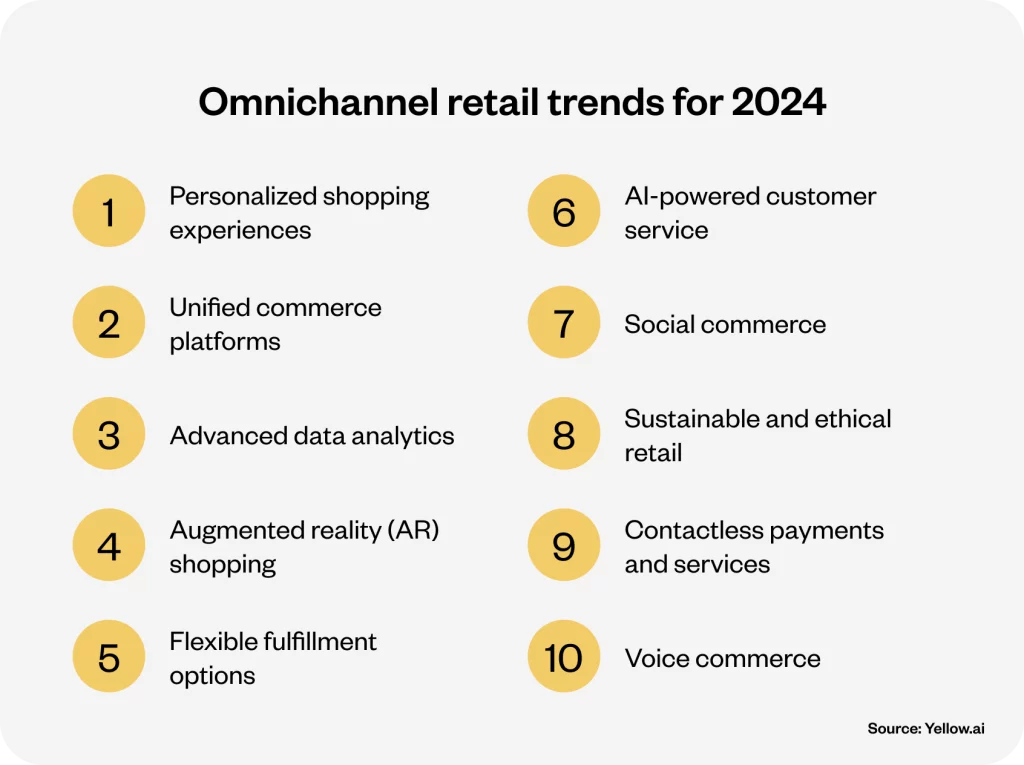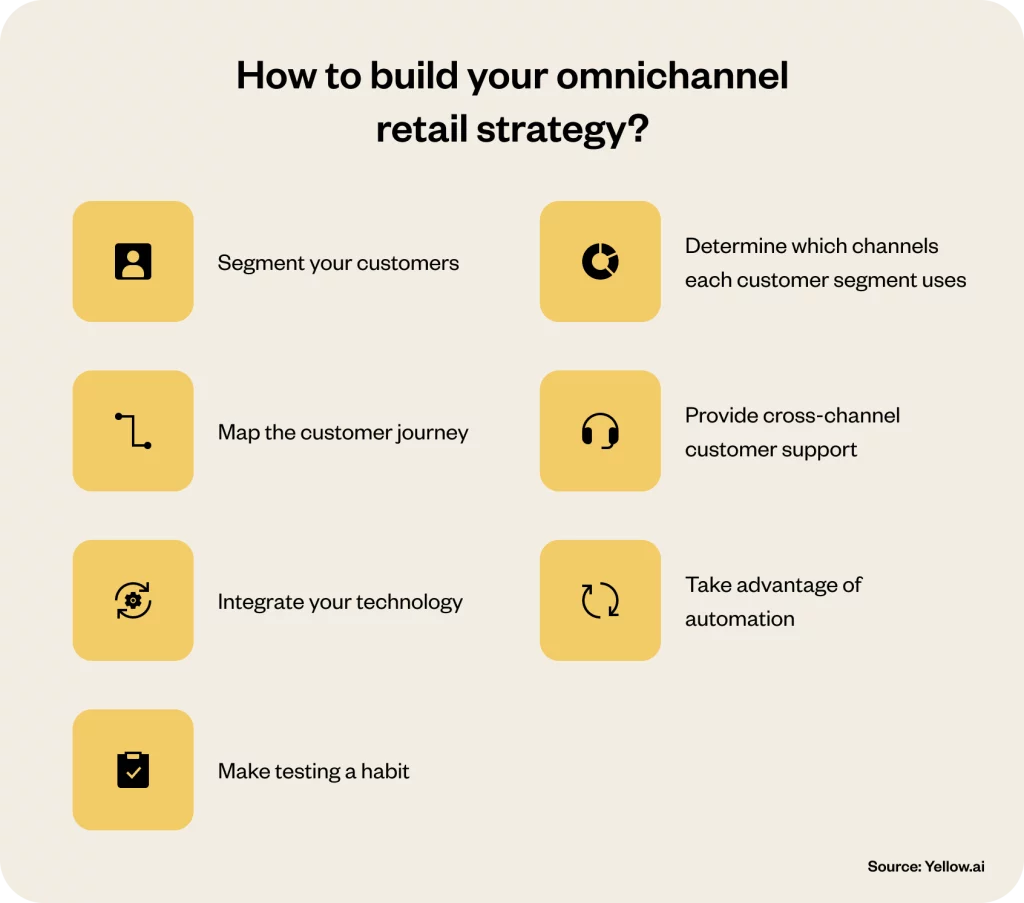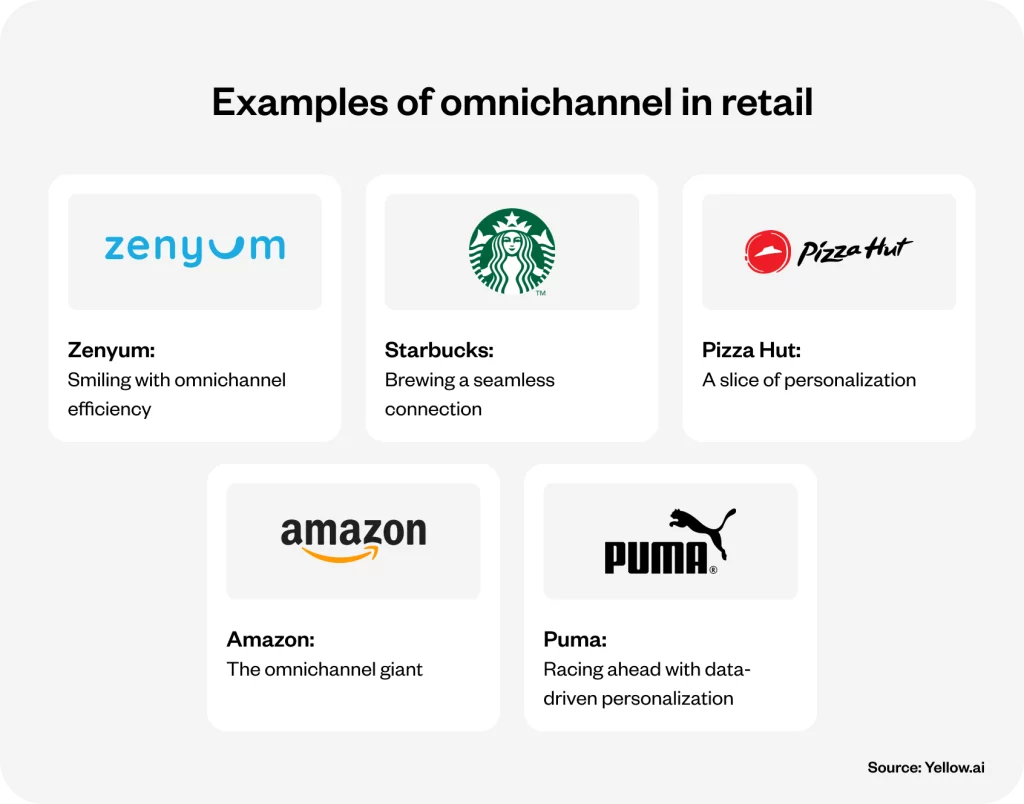Ringkasan eksekutif
Ritel omnichannel mengubah belanja menjadi pengalaman mulus yang mencakup ruang online dan fisik. Blog ini mengungkap strategi ritel omnichannel—definisinya, contoh-contoh yang berdampak, dan tren terkini. Ini menyoroti bagaimana pendekatan ini melebihi harapan pelanggan dengan menggabungkan kenyamanan belanja online dengan manfaat nyata dari pengalaman di dalam toko. Untuk bisnis yang bertujuan untuk berkembang di era digital, merangkul ritel omnichannel bukan hanya pilihan tetapi kebutuhan.
Perkenalan
Bayangkan dunia belanja di mana keranjang online dan wishlist di dalam toko Anda sama, di mana ranah digital dan fisik ritel tidak hanya bertemu tetapi bergabung. Ini adalah jantung dari ritel omnichannel. Dengan 58% konsumen siap untuk berbelanja lebih banyak secara online pasca-pandemi dan 85% pembeli di Inggris pada tahun 2019 masih menghargai pengalaman di dalam toko, seruan untuk perjalanan belanja terpadu tidak pernah lebih keras. Ritel omnichannel menjawab panggilan ini, memastikan bahwa apakah Anda menggesek layar atau berjalan-jalan di lorong, pengalaman berbelanja Anda selalu menyenangkan.
Dalam lanskap ritel saat ini, garis antara belanja online dan offline kabur, menciptakan perjalanan pelanggan yang fleksibel, intuitif, dan, di atas segalanya, berpusat di sekitar preferensi konsumen. Blog ini menjelajah ke alam semesta omnichannel, mengeksplorasi bagaimana ia membentuk kembali ritel dengan memberikan pengalaman pelanggan yang kohesif di semua saluran. Dari memanfaatkan AI untuk memprediksi pembelian wajib berikutnya hingga menawarkan opsi penjemputan yang sesuai dengan hari Anda, ritel omnichannel adalah tentang bertemu dengan Anda, pelanggan, di mana pun Anda berada.
Apa itu ritel omnichannel?
Omnichannel ritel adalah semua tentang membuat belanja mudah dan menyenangkan, tidak peduli di mana atau bagaimana pelanggan memilih untuk berbelanja. Ini adalah strategi yang mengikat dunia online dan offline, memastikan bahwa apakah pelanggan mengetuk smartphone mereka atau berkeliaran di lorong, mereka mendapatkan getaran belanja yang konsisten dan personal. Pendekatan ini memungkinkan pembeli melompat dari web ke toko ke aplikasi semulus membalik-balik halaman majalah favorit mereka, dengan preferensi dan petualangan belanja masa lalu yang memandu jalan.
Mengapa ini penting untuk bisnis? Di era digital, pelanggan adalah raja dan ratu kerajaan belanja mereka, berharap untuk dikenal dan dilayani di semua saluran. Mereka mungkin melihat sesuatu yang mereka sukai di Instagram, memeriksanya di situs web, dan kemudian berayun ke toko untuk mengambilnya. Omnichannel ritel membuat perjalanan ini tidak hanya mungkin tetapi mulus. Ini tentang mengenal pelanggan Anda dengan sangat baik sehingga apakah mereka online, di ponsel mereka, atau di toko Anda, Anda menawarkan apa yang mereka inginkan, seringkali bahkan sebelum mereka bertanya.
Perusahaan merangkul ritel omnichannel untuk dampak transformatifnya. Pendekatan ini meningkatkan loyalitas pelanggan, meningkatkan penjualan, dan merampingkan rintangan operasional, memastikan produk diposisikan secara tepat untuk memenuhi permintaan. Ini adalah skenario yang saling menguntungkan: pembeli menikmati perjalanan berbelanja yang disesuaikan dan mudah, mirip dengan layanan pramutamu yang dipesan lebih dahulu, sementara perusahaan menyaksikan pertumbuhan yang nyata. Poros ke ritel omnichannel menandai era baru dalam perdagangan, menggabungkan teknologi dengan sentuhan pribadi untuk merevolusi pengalaman berbelanja.
Masa depan omnichannel di bidang ritel
Masa depan ritel omnichannel adalah perjalanan menuju kenyamanan dan personalisasi yang belum pernah terjadi sebelumnya, menggabungkan pengalaman digital dengan interaksi fisik secara mulus. Saat kita melihat ke cakrawala ritel, terbukti bahwa ekspektasi pelanggan melonjak menuju masa depan di mana perbedaan antara belanja online dan offline menghilang. Seruan untuk keunggulan omnichannel tidak lagi menjadi bisikan tetapi permintaan yang besar. Hal ini mendorong pengecer untuk terus berinovasi.
Ritel omnichannel siap untuk mendefinisikan kembali pengalaman berbelanja dengan mengintegrasikan teknologi transformatif seperti augmented reality (AR), kecerdasan buatan (AI), dan komputasi awan. Inovasi-inovasi ini merupakan perubahan mendasar yang memungkinkan pengecer menciptakan perjalanan belanja yang mendalam dan personal.
Bayangkan berjalan ke toko di mana cermin AR memungkinkan Anda mencoba pakaian tanpa mengubah atau rekomendasi AI memandu keputusan pembelian Anda berdasarkan riwayat belanja dan preferensi Anda. Ini adalah masa depan di mana teknologi mengantisipasi kebutuhan Anda dan menawarkan pengalaman berbelanja yang sangat memuaskan dan mengejutkan.
Selain itu, tulang punggung ritel omnichannel yang berbasis data akan memberdayakan pengecer untuk memahami pelanggan mereka dengan cara yang belum pernah ada sebelumnya. Dengan analisis tingkat lanjut, bisnis dapat mengungkap tren, memprediksi perilaku, dan menyesuaikan penawaran mereka untuk memenuhi tuntutan pelanggan mereka. Tingkat wawasan ini akan sangat penting karena pengecer menavigasi dunia pasca-cookie, di mana metode pelacakan dan penargetan tradisional menjadi usang.
Masa depan adalah milik mereka yang memanfaatkan data mereka dengan bijak, menciptakan nilai bagi pelanggan mereka sambil menghormati privasi mereka. Saat kita bergerak maju, pengecer yang berkembang akan menjadi mereka yang memandang teknologi sebagai bagian integral dari identitas merek mereka. Ini akan memadukan inovasi dengan sentuhan manusia secara mulus untuk menciptakan pengalaman berbelanja yang merupakan peristiwa berkesan.
Tren ritel multisaluran untuk tahun 2024
Strategi omnichannel dalam ritel merevolusi bagaimana bisnis berinteraksi dengan pelanggan mereka. Dengan tahun 2024 di cakrawala, mari kita bongkar tren yang ditetapkan untuk mendefinisikan kembali lanskap ritel. Mengetahui tren ini akan memastikan bahwa bisnis Anda tidak hanya mengimbangi tetapi merupakan langkah maju dalam memberikan pengalaman pelanggan yang luar biasa.

1. Pengalaman berbelanja yang dipersonalisasi
Era one-size-fits-all sudah lama berlalu. Pada tahun 2024, harapkan pengalaman berbelanja yang sangat personal di mana AI dan analisis data menyusun profil pelanggan individu untuk menyesuaikan rekomendasi, penawaran, dan konten produk. Itu akan membuat setiap perjalanan belanja seunik pelanggan itu sendiri.
2. Platform perdagangan terpadu
Silo rusak, memberi jalan kepada platform perdagangan terpadu yang mengintegrasikan penjualan, pemasaran, dan layanan pelanggan. Interaksi yang lancar di semua saluran, baik online, dalam aplikasi, atau di dalam toko, berarti pelanggan dapat beralih antar saluran dengan mudah, menjaga kesinambungan pengalaman berbelanja mereka.
3. Analisis data tingkat lanjut
Data adalah emas baru dalam ritel omnichannel. Alat analisis tingkat lanjut dapat memberikan wawasan lebih dalam tentang perilaku, preferensi, dan tren pelanggan. Ini akan memungkinkan pengecer untuk memprediksi kebutuhan pelanggan, mengoptimalkan inventaris, dan mempersonalisasi upaya pemasaran dengan lebih efektif daripada sebelumnya.
4. Belanja augmented reality (AR)
Augmented reality membawa pengalaman belanja online ke tingkat lain. Pada tahun 2024, AR akan memungkinkan pelanggan untuk memvisualisasikan produk di ruang dan kenyamanan mereka sendiri sebelum melakukan pembelian, apakah itu mencoba pakaian secara virtual atau melihat bagaimana sofa baru cocok di ruang tamu mereka.
5. Pilihan pemenuhan yang fleksibel
Fleksibilitas adalah kunci pemenuhan. Pelanggan mengharapkan berbagai pilihan yang sesuai dengan kenyamanan mereka, mulai dari pengiriman pada hari yang sama hingga pembelian-online-pick-up-in-store (BOPIS) dan penjemputan di tepi jalan. Pengecer perlu menyesuaikan logistik mereka untuk menawarkan opsi fleksibel ini tanpa mengurangi efisiensi.
6. Layanan pelanggan yang didukung AI
AI akan terus mengubah layanan pelanggan, dengan chatbot dan asisten virtual memberikan dukungan instan 24/7. Solusi AI ini akan menjadi lebih canggih, menangani pertanyaan kompleks dengan mudah dan mempersonalisasi interaksi berdasarkan riwayat dan preferensi pelanggan.
Baca terkait: AI chatbot – Panduan lengkap untuk [2024]
7. Perdagangan sosial
Belanja di platform media sosial diatur untuk tumbuh. Dengan fitur terintegrasi “beli sekarang” dan posting yang dapat dibeli, pelanggan dapat melakukan pembelian langsung melalui media sosial, mengaburkan batas antara browsing dan membeli dan membuat setiap interaksi menjadi peluang untuk berbelanja.
8. Ritel berkelanjutan dan etis
Konsumen semakin sadar akan jejak ekologis mereka. Hal ini mendorong permintaan akan produk-produk yang berkelanjutan dan bersumber secara etis. Pengecer harus berbagi praktik mereka secara transparan dan menawarkan produk yang selaras dengan nilai-nilai ini agar tetap relevan.
9. Pembayaran dan layanan tanpa kontak
Permintaan akan transaksi nirsentuh, yang didorong oleh masalah kesehatan dan kebutuhan akan kenyamanan, akan terus meningkat. Pengecer akan memperluas opsi dan layanan pembayaran nirsentuh mereka, membuat belanja lebih aman dan efisien.
10. Perdagangan suara
Belanja yang diaktifkan dengan suara sedang meningkat. Karena speaker pintar dan asisten suara mendapatkan popularitas yang luar biasa, berbelanja melalui perintah suara akan menjadi lebih umum, menawarkan pengalaman berbelanja tanpa hambatan dan tanpa kerumitan.
Manfaat ritel omnichannel
Dalam dunia ritel yang dinamis, mengadopsi pendekatan omnichannel bukan sekadar peningkatan—, ini adalah sebuah revolusi. Berikut adalah bagaimana strategi ini mengubah permainan untuk bisnis dan pelanggan sama:

1. Pengalaman pelanggan yang ditingkatkan
Bisnis sering menemukan diri mereka berjuang dengan tantangan untuk mengimbangi harapan pelanggan yang berkembang. Namun, ritel omnichannel menjembatani kesenjangan antara belanja digital dan fisik, menawarkan pengalaman terpadu. Pelanggan tidak lagi membedakan antara online dan offline – mereka mencari keunggulan di semua platform. Dengan bertemu pelanggan di mana mereka berada, bisnis dapat mendorong perjalanan yang mulus dari layar ke toko. Itu meningkatkan pengalaman pelanggan secara keseluruhan.
2. Peningkatan loyalitas pelanggan
Menumbuhkan hubungan pelanggan yang langgeng sangat penting bagi bisnis. Pengalaman yang dipersonalisasi dan kualitas yang konsisten di semua saluran secara alami mengarah pada loyalitas pelanggan yang lebih dalam. Pelanggan yang merasa dipahami dan dihargai cenderung bertahan terlepas dari bagaimana mereka berinteraksi dengan merek Anda. Loyalitas ini diterjemahkan ke dalam garis bawah yang lebih kuat, membuktikan bahwa layanan yang baik adalah strategi bisnis terbaik.
3. Peningkatan wawasan pelanggan
Memungut wawasan yang dapat ditindaklanjuti dari data pelanggan adalah saus rahasia untuk kesuksesan bisnis di dunia digital ini. Pendekatan omnichannel menghasilkan banyak data di seluruh titik kontak. Dengan menganalisis data ini, bisnis dapat membuka wawasan tentang preferensi dan perilaku pelanggan. Hal ini memungkinkan bisnis untuk membuat keputusan yang lebih cerdas dan berbasis data yang membuat mereka tetap terdepan.
4. Penjualan dan pendapatan lebih tinggi
Meningkatkan penjualan dalam lanskap yang kompetitif adalah tantangan yang dihadapi hampir setiap bisnis. Menawarkan beberapa saluran belanja dan keterlibatan yang terintegrasi, ritel omnichannel memanfaatkan potensi pengeluaran yang meningkat. Pelanggan yang menikmati pengalaman berbelanja tanpa gesekan di seluruh platform terbukti menghabiskan lebih banyak, mendorong penjualan dan pendapatan yang lebih tinggi.
5. Manajemen inventaris yang lebih baik
Menyederhanakan inventaris di berbagai saluran dapat menjadi tugas yang menantang bagi bisnis ritel. Ritel omnichannel memecahkan tantangan ini dengan mudah. Manajemen inventaris real-time menjadi mudah dengan strategi omnichannel. Efisiensi ini mengurangi overstock dan stockout, memastikan pelanggan menemukan apa yang mereka butuhkan saat mereka membutuhkannya, yang, pada gilirannya, mendukung penjualan dan kepuasan pelanggan.
6. Peningkatan jangkauan dan penetrasi pasar
Memperluas kehadiran pasar Anda di dunia digital-first ini adalah suatu keharusan. Ritel omnichannel membuka jalan baru untuk menjangkau pelanggan, mulai dari media sosial hingga pembelian dalam aplikasi. Ini memperluas jejak pasar Anda dan menarik basis pelanggan yang beragam.
7. Operasi yang disederhanakan
Mengoptimalkan efisiensi operasional adalah kunci utama dari setiap bisnis ritel yang sukses. Mengintegrasikan dan mengotomatisasi proses di seluruh saluran akan menyederhanakan operasi, meningkatkan produktivitas, dan mengurangi biaya. Kelincahan operasional ini memungkinkan bisnis untuk fokus pada pertumbuhan dan inovasi.
Satukan CX Anda dengan otomatisasi AI omnichannel

8. Keunggulan kompetitif
Menonjol di pasar yang jenuh adalah area inti fokus dalam pertemuan bisnis ritel hari ini. Menawarkan pengalaman omnichannel yang unggul memposisikan merek Anda sebagai pemimpin. Ini membedakan Anda dari pesaing dan menarik perhatian pelanggan yang cerdas.
9. Fleksibilitas dan kemampuan beradaptasi
Mengimbangi perubahan pasar juga penting. Pendekatan omnichannel melengkapi bisnis dengan kelincahan untuk cepat beradaptasi dengan tren pasar dan harapan pelanggan. Itu memastikan relevansi dan kesuksesan jangka panjang.
10. Persepsi merek yang ditingkatkan
Bisnis terus bekerja untuk membangun citra merek yang positif. Pendekatan omnichannel juga membantu dalam hal ini. Bisnis yang berhasil menerapkan strategi omnichannel dipandang sebagai customer-centric dan inovatif. Ini meningkatkan persepsi dan loyalitas merek secara keseluruhan.
Bagaimana membangun strategi ritel omnichannel Anda?
Dalam lanskap ritel saat ini, menciptakan strategi omnichannel yang kohesif adalah kebutuhan untuk terhubung dengan pelanggan di berbagai titik kontak. Bagian ini menggali langkah-langkah praktis untuk membangun strategi ritel omnichannel yang sesuai dengan tujuan bisnis dan kebutuhan pelanggan Anda.

1. Segmentasikan pelanggan Anda
Landasan pertama dari strategi omnichannel yang kuat adalah memahami siapa pelanggan Anda. Segmentasi memungkinkan Anda untuk mengkategorikan audiens Anda berdasarkan berbagai atribut seperti demografi, perilaku pembelian, dan preferensi keterlibatan. Ini memungkinkan komunikasi yang dipersonalisasi dan pengalaman berbelanja yang disesuaikan.
Baca terkait: Segmentasi pelanggan: Panduan utama
Tips implementasi
- Memanfaatkan alat CRM untuk menganalisis data pelanggan dan mengidentifikasi segmen yang berbeda.
- Pertimbangkan faktor-faktor seperti kebiasaan pembelian, preferensi produk, dan saluran keterlibatan untuk menciptakan kelompok yang bermakna.
2. Tentukan saluran mana yang digunakan setiap segmen pelanggan
Menyadari bahwa segmen pelanggan yang berbeda dapat terlibat dengan merek Anda melalui berbagai saluran sangatlah penting. Mengidentifikasi dan memprioritaskan saluran ini memungkinkan Anda untuk bertemu pelanggan Anda di tempat yang paling nyaman dan terlibat.
Tips implementasi
- Melakukan survei atau menganalisis data interaksi pelanggan untuk memahami preferensi saluran.
- Prioritaskan investasi Anda di saluran yang selaras dengan preferensi segmen Anda yang paling berharga.
3. Petakan perjalanan pelanggan
Peta perjalanan pelanggan yang komprehensif menguraikan setiap interaksi yang dimiliki pelanggan dengan merek Anda, mulai dari kesadaran awal hingga dukungan pembelian dan pasca pembelian. Ini menyoroti titik kontak penting di mana keterlibatan yang dipersonalisasi dapat meningkatkan pengalaman pelanggan.
Related read: Manfaat pemetaan perjalanan pelanggan
Tips implementasi
- Berkolaborasi dengan tim di seluruh organisasi Anda untuk memastikan pandangan komprehensif tentang perjalanan pelanggan.
- Gunakan umpan balik dan data pelanggan nyata untuk memvalidasi dan menyempurnakan peta perjalanan Anda.
4. Memberikan dukungan pelanggan lintas saluran
Dukungan pelanggan yang konsisten dan berkualitas tinggi di semua saluran memperkuat kepercayaan dan loyalitas pelanggan. Memastikan pelanggan menerima tingkat layanan yang sama secara online, dalam aplikasi, dan di dalam toko tidak dapat dinegosiasikan dalam strategi omnichannel.
Tips implementasi
- Menerapkan platform layanan pelanggan terpadu yang mengintegrasikan semua saluran, memungkinkan transfer dan pelacakan pertanyaan pelanggan dengan mudah.
- Latih tim dukungan Anda untuk memberikan bantuan yang dipersonalisasi, memanfaatkan riwayat dan preferensi pelanggan yang dapat diakses di semua saluran.
5. Integrasikan teknologi Anda
Tumpukan teknologi kohesif yang menghubungkan platform e-commerce, CRM, manajemen inventaris, dan sistem dukungan pelanggan Anda sangat penting untuk memberikan pengalaman pelanggan yang terpadu.
Tips implementasi
- Pilih solusi teknologi yang menawarkan kemampuan integrasi dengan sistem Anda yang ada.
- Secara teratur meninjau dan memperbarui tumpukan teknologi Anda untuk memastikannya memenuhi kebutuhan bisnis yang berkembang dan harapan pelanggan.
6. Manfaatkan otomatisasi
Penggunaan otomatisasi secara strategis dapat meningkatkan efisiensi operasional dan keterlibatan pelanggan secara signifikan. Sistem otomatis dapat menangani tugas yang berulang, membebaskan tim Anda untuk fokus pada aktivitas bernilai tinggi dan memberikan interaksi pelanggan yang dipersonalisasi dalam skala besar.
Tips implementasi
- Menerapkan chatbot untuk pertanyaan pelanggan 24/7 dan tugas dukungan dasar.
- Gunakan alat otomatisasi email untuk mengirim rekomendasi dan penawaran produk yang dipersonalisasi berdasarkan perilaku pelanggan.
7. Jadikan tes sebagai kebiasaan
Pengujian dan pengoptimalan yang berkelanjutan sangat penting untuk mempertahankan strategi omnichannel yang efektif yang berkembang seiring dengan ekspektasi pelanggan dan dinamika pasar.
Tips implementasi
- A/B menguji berbagai aspek strategi omnichannel Anda, mulai dari pesan pemasaran hingga desain situs web, untuk mengidentifikasi apa yang paling berhasil.
- Gunakan umpan balik pelanggan dan data kinerja untuk menginformasikan hipotesis dan penyesuaian pengujian Anda.
Contoh omnichannel di ritel
Dalam lanskap ritel yang berkembang pesat, bisnis semakin mengadopsi strategi omnichannel untuk memberikan pengalaman berbelanja yang lancar. Di sini, kami menyelidiki contoh dunia nyata dari perusahaan yang telah berhasil menerapkan ritel omnichannel, menetapkan tolok ukur untuk keterlibatan pelanggan dan keunggulan operasional.

Zenyum: Tersenyum dengan efisiensi omnichannel
Zenyum, pemain dinamis di sektor teknologi perawatan kesehatan Asia Tenggara, mencontohkan kesuksesan omnichannel. Menghadapi tantangan mengelola interaksi pelanggan yang luas di berbagai saluran, Zenyum memanfaatkan kekuatan Yellow.ai untuk memperkenalkan asisten virtual yang beroperasi dengan lancar di situs web mereka, Facebook Messenger, Instagram, dan WhatsApp. Pendekatan berbasis AI ini tidak hanya mempersonalisasi pengalaman pelanggan dalam skala besar tetapi juga mencerminkan interaksi seperti manusia, meningkatkan keterlibatan tanpa kebutuhan konstan akan intervensi manusia.
Hasilnya menunjukkan banyak hal: lebih dari 12.000 pengguna baru terlibat melalui saluran ini dalam waktu satu tahun, menunjukkan kapasitas asisten virtual untuk menangani volume interaksi yang signifikan sambil mempertahankan sentuhan yang dipersonalisasi.
Starbucks: Menyeduh koneksi yang mulus
Starbucks, yang terkenal dengan kopi dan layanan pelanggannya, memanfaatkan ritel omnichannel untuk meningkatkan program loyalitas pelanggannya. Dengan mengintegrasikan kartu fisik dan aplikasi seluler mereka, Starbucks memungkinkan pelanggan mendapatkan hadiah, memesan terlebih dahulu, dan menikmati musik yang diputar di dalam toko, serta fitur-fitur lainnya. Pengalaman kohesif ini menumbuhkan rasa loyalitas dan kenyamanan, memperkuat posisi Starbucks sebagai pemimpin omnichannel.
Pizza Hut: Sepotong personalisasi
Pizza Hut UK mengatasi masalah umum komunikasi email satu dimensi dengan mengadopsi pendekatan omnichannel yang berpusat pada pelanggan. Dengan meminta data pihak pertama melalui kampanye selamat datang, Pizza Hut memperoleh wawasan berharga mengenai preferensi pelanggan, memungkinkan mereka mempersonalisasi perjalanan pelanggan secara efektif. Upaya mereka dalam personalisasi kampanye loyalitas, yang didukung oleh Emarsys, secara signifikan meningkatkan keterlibatan pelanggan, menunjukkan dampak dari strategi omnichannel yang diatur dengan baik.
Amazon: Raksasa omnichannel
Pendekatan Amazon yang berpusat pada pelanggan dicontohkan oleh strategi omnichannel-nya. Dengan memanfaatkan data pelanggan yang luas, Amazon menawarkan pengalaman berbelanja yang dipersonalisasi dan nyaman, memungkinkan pelanggan berbelanja dengan persyaratan mereka sendiri. Pengenalan Amazon Prime, mengatasi hambatan biaya pengiriman, semakin menggarisbawahi komitmen mereka untuk menghilangkan gesekan dari proses belanja, membuktikan nilai pemahaman dan bertindak berdasarkan wawasan pelanggan.
Puma: Berlomba dengan personalisasi berbasis data
Pendekatan omnichannel Puma mengubah strategi pemasarannya dari buletin massal menjadi komunikasi yang terarah dan dipersonalisasi. Dengan menyatukan data pelanggannya, Puma mampu mengelompokkan audiensnya secara efektif dan menyesuaikan upaya pemasarannya, sehingga menghasilkan peningkatan signifikan dalam pendapatan, keterlibatan, dan pertumbuhan basis data. Transformasi ini menyoroti pentingnya data dalam menyusun perjalanan pelanggan yang dipersonalisasi.
Ciptakan pengalaman ritel omnichannel untuk merek Anda hari ini.
Saat kita mendalami bidang transformasi ritel, penting untuk menyoroti esensi pengalaman berbelanja terpadu yang dapat dicapai dengan menggunakan teknologi futuristik. Di situlah Yellow.ai melangkah masuk, menjembatani kesenjangan antara potensi dan kinerja dalam lanskap omnichannel. Perusahaan ini telah memelopori otomatisasi yang sangat baik dalam layanan pelanggan untuk merek di seluruh industri dengan pendekatan multi-cabang. Platform Yellow.ai direkayasa untuk merevolusi bagaimana bisnis terhubung dengan pelanggan mereka di seluruh saluran apa pun, memastikan perjalanan ritel yang harmonis dan personal dari awal hingga akhir. Misalnya, pertimbangkan untuk menggunakan Otomatisasi Platform Dinamis atau DAP multibahasa kami, yang membantu memangkas pengeluaran sebanyak 60%. Dengan itu, Anda dapat mendukung pelanggan Anda 24/7 dan menanggapi pertanyaan mereka secara instan melalui saluran pilihan mereka.
Fitur utama:
- Integrasi omnichannel: Terhubung secara mulus dengan pelanggan di seluruh web, seluler, media sosial, dan saluran di dalam toko, memberikan pengalaman yang konsisten di mana-mana.
- Chatbot yang didukung AI: Terapkan chatbot cerdas di seluruh situs web Anda, platform media sosial, dan aplikasi perpesanan untuk melibatkan pelanggan 24/7.
- Interaksi pelanggan yang dipersonalisasi: Memanfaatkan pembelajaran mesin untuk menganalisis perilaku pelanggan dan menyesuaikan interaksi untuk perjalanan belanja yang lebih personal.
- Pelacakan produk menyeluruh: Tawarkan kepada konsumen Anda pengalaman ritel tanpa batas yang mencakup informasi real-time tentang kemajuan pengiriman produk dan pelacakan di setiap tahap.
- Integrasi yang mulus: Chatbot Yellow.ai dengan mudah berintegrasi dengan CRM, platform e-commerce, dan sistem manajemen inventaris Anda yang ada, memastikan pengalaman merek yang terpadu.
- Analisis real-time: Dapatkan wawasan tentang preferensi dan perilaku pelanggan dengan analisis tingkat lanjut, memungkinkan keputusan berbasis data untuk meningkatkan pengalaman ritel.
- Dukungan multibahasa: Hancurkan hambatan bahasa dan terhubung dengan basis pelanggan global dengan chatbot yang berkomunikasi dalam lebih dari 135 bahasa dan dialek.
Siap untuk meningkatkan strategi ritel Anda?

Pemikiran terakhir
Perjalanan melalui lanskap ritel omnichannel yang terus berkembang mengungkap masa depan di mana batasan antara belanja digital dan fisik hilang. Ini adalah masa depan di mana teknologi seperti Yellow.ai mengantisipasi kebutuhan bisnis dan memberdayakan mereka untuk memenuhi pelanggan dengan presisi dan personalisasi yang tak tertandingi. Di era ini, komitmen terhadap pendekatan omnichannel melampaui tren— yang menjadi landasan pertumbuhan ritel. Saat kami merangkul solusi transformatif ini, kami membuka pintu untuk kemungkinan-kemungkinan baru, menempa koneksi yang lebih dalam dan menciptakan pengalaman yang beresonansi dengan setiap titik kontak pelanggan. Jalannya jelas; waktu untuk bertindak adalah sekarang. Mari kita menavigasi perjalanan ini bersama-sama, mendefinisikan ulang ritel dengan setiap langkah maju.
Pertanyaan yang sering diajukan (FAQ)
Apa itu strategi ritel omnichannel?
Strategi ritel omnichannel mengintegrasikan berbagai metode belanja yang tersedia bagi konsumen, seperti online, di dalam toko, dan melalui perangkat seluler. Pendekatan ini memberikan pengalaman pelanggan yang kohesif, memastikan interaksi yang konsisten dan keterlibatan yang dipersonalisasi di semua platform.
Bagaimana strategi omnichannel dapat meningkatkan operasi saya?
Menerapkan strategi omnichannel merampingkan operasi dengan menyatukan upaya penjualan dan pemasaran, meningkatkan manajemen inventaris, dan memberikan wawasan terperinci tentang perilaku pelanggan. Pandangan holistik ini memungkinkan bisnis untuk mengoptimalkan proses mereka, meningkatkan kepuasan pelanggan, dan meningkatkan efisiensi.
Apakah omnichannel adalah masa depan ritel?
Ya, omnichannel secara luas dianggap sebagai masa depan ritel. Hal ini sejalan dengan ekspektasi konsumen yang terus berkembang terhadap pengalaman berbelanja yang lancar dan dipersonalisasi di berbagai saluran, mendorong keterlibatan, loyalitas, dan penjualan.
Siapa pengecer omnichannel terbaik?
Beberapa merek unggul dalam ritel omnichannel, seperti Amazon, Starbucks, dan Zara, masing-masing menawarkan pengalaman belanja yang unik dan mulus yang secara efektif mengintegrasikan kehadiran online dan offline mereka.
Apa perbedaan antara omnichannel dan multichannel?
Perbedaan utama antara multisaluran dan omnichannel terletak pada integrasi dan pengalaman pelanggan. Ritel multisaluran melibatkan penggunaan banyak saluran untuk melibatkan pelanggan, sering kali beroperasi di silo. Omnichannel ritel, bagaimanapun, memastikan saluran ini sepenuhnya terintegrasi, memberikan pengalaman pelanggan yang terpadu dan mulus terlepas dari platform atau perangkat yang digunakan.





















